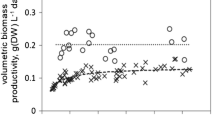Abstract
The effects of the algicides terbutryn and copper sulfate on the potential for reducing the gaseous loss of NH3 from urea applied to rice were examined in experiments with 2 methods of N fertilizer management, 2 or 3 N rates, and 3 algicide treatments. The experiments were conducted during the 1986 dry and wet seasons in an experimental field at Pila, Laguna, Philippines.
Copper sulfate had little effect as an algicide at the rate used, but terbutryn immediately reduced algal growth. The populations of species resistant to terbutryn probably increased, but terbutryn had no long-term effect on the total number of colony-forming units of algae. There was some evidence that terbutryn reduced photodependent N2 fixation as estimated by acetylene reduction assay.
Terbutryn, when applied with urea 10 days after transplanting, reduced the maximum floodwater pH by 0.9 units or more for 7 d in the DS and by about 0.5 units for 8 d in the WS. Terbutryn increased the ammoniacal-N (AN) concentration in the floodwater 100% or more in the DS and 60% in the WS. The combined effect of terbutryn on the floodwater pH and AN concentration was reduced photodependent NH3 partial pressure (ρNH3), about 25% in the DS and 38% in the WS.
Similar content being viewed by others
References
Bowmer KH and Muirhead WA (1987) Inhibition of algal photosynthesis to control pH and reduce ammonia volatilization from rice floodwater. Fert Res 13: 13–29
Cai GX, Freney JR, Humphreys E, Denmead OT, Samson M and Simpson JR (1987) Use of surface films to reduce ammonia volatilization from flooded rice fields. Aust J Agric Res 39: 177–186
Cao ZH, De Datta SK and Fillery IRP (1984) Effect of placement methods on floodwater properties and recovery of applied N (15N-labeled urea) in wetland rice. Soil Sci Soc Am J 48: 196–203
De Datta SK, Obcemea WN, Chen RY, Calabio JC and Evangelista RC (1987) Effect of water depth on nitrogen use efficiency and nitrogen-15 balance in lowland rice. Agron J 79: 210–216
Fillery IRP, Simpson JR and De Datta SK (1984) Influence of field environment and fertilizer management on ammonia loss from flooded rice. Soil Sci Soc Am J 48: 914–920
Focht DD (1979) Microbial kinetics of nitrogen losses in flooded soils. In: Nitrogen and Rice. pp. 119–132. Los Baňos, Philippines: International Rice Research Institute
Freney JR, Trevitt ACF, Muirhead WA, Denmead OT, Simpson JR and Obcemea WN (1988) Effect of water depth on ammonia loss from lowland rice. Fert Res 16: 97–107
IRRI (1984) Autotrophic nitrogen fixation, pp 270–273. In: The International Rice Research Institute, PO Box 933 Manila, Philippines. Annual Report for 1984
Leuning R, Denmead OT, Simpson JR and Freney JR (1984) Processes of ammonia loss from shallow floodwater. Atmos Environ 18: 1583–1592
Mikkelsen DS, De Datta SK and Obcemea WN (1978) Ammonia volatilization losses from flooded rice soils. Soil Sci Soc Am J 42: 725–730
Palmer CM (1962) Algae in water supplies. Public Health Service Pub. No. 657. U.S. Department of Health, Education and Welfare, Washington, DC
Roger PA, Kulasooriya SA, Tirol AC and Craswell ET (1980) Deep placement: a method of nitrogen fertilizer application compatible with algal nitrogen fixation in wetland rice soils. Plant Soil 57: 137–142
Roger PA, Reddy PM and Remuella-Jimenez R (1988) Photodependent acetylene reducing activity (ARA) in rice fields under various fertilizer and biofertilizer management. p 827. In: Nitrogen Fixation: Hundred Years After. Bothe H, de Bruijn FJ, Newton WE eds, Gustav Fischer, eds
Roger PA, Santiago-Ardales S and Watanabe I (1986) Nitrogen fixing blue-green algae in rice soils of northern Luzon (Philippines). Phil Agri 69: 589–598
Setter TL, Jackson MB, Waters I, Wallace I and Greenway H (1988) Floodwater carbon dioxide and ethylene concentrations as factors in chlorosis development and reduced growth of completely submerged rice. In: 1987 International Deepwater Rice Workshop, IRRI Los Baňos, Philippines
Simpson JR, Freney JR, Wetselaar R, Muirhead WA, Leuning R and Denmead OT (1984) Transformation and losses of urea nitrogen after application to flooded rice. Aust J Agric Res 35: 189–200
Simpson JR, Muirhead WA, Bowmer KH, Cai GX and Freney JR (1988) Control of gaseous nitrogen losses from urea applied to flooded rice soils. Fert Res (in press)
Vlek PLG and Craswell ET (1979) Effect of nitrogen source and management on ammonia volatilization losses from flooded rice-soil systems. Soil Sci Soc Am J 43: 352–358
Vlek PLG, Stumpe JM and Byrnes BH (1980) Urease activity and inhibition in flooded soil systems. Fert Res 1: 191–202
Watanabe I, De Datta SK and Roger PA (1988) Nitrogen cycling in wetland rice soils. In: Wilson JR (ed) Advances in Nitrogen Cycling in Agricultural Ecosystems pp. 239–256 Wallingford UK, CAB International
Author information
Authors and Affiliations
Additional information
deceased
Rights and permissions
About this article
Cite this article
Muirhead, W.A., De Datta, S.K., Roger, P.A. et al. Effect of algicides on urea fertilizer efficiency in transplanted rice. Fertilizer Research 21, 95–107 (1989). https://doi.org/10.1007/BF01080534
Received:
Accepted:
Issue Date:
DOI: https://doi.org/10.1007/BF01080534




